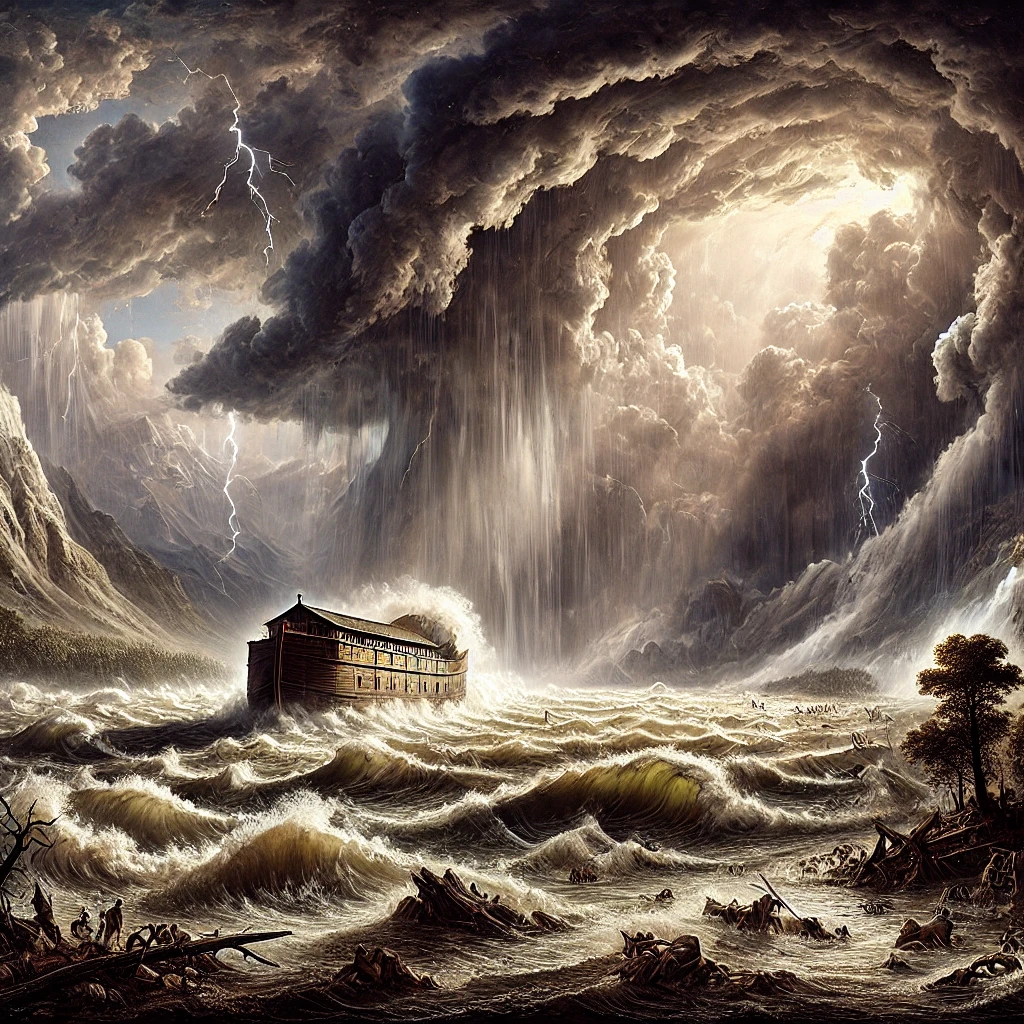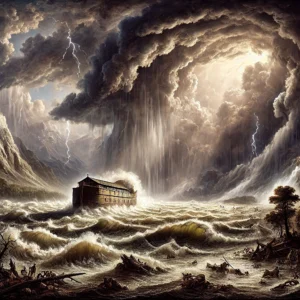
Part 5. Flood

Part 5. Flood
I would like to clarify a nuance related to the unusually long lifespans of Adam and other biblical figures from the perspective of today’s understanding of average life expectancy.
Let us suppose that Earth is located in the gravitational field of a black hole. According to Einstein’s general theory of relativity, the strong gravitational field of a black hole can slow down time. This phenomenon is known as gravitational time dilation and can be observed for objects near sources of intense gravitational influence, such as black holes.
In this context, if we imagine that Earth was closer to a black hole in the past, gravitational time dilation could have significantly affected the measurement of time on Earth. Thus, the time intervals perceived by observers on Earth as very long could have actually been much shorter. This provides a possible explanation for the longevity of biblical figures like Adam, Noah, and Abraham, whose lifespans, according to the texts, spanned hundreds of years.
Therefore, the hypothesis of Earth’s proximity to a black hole in ancient times offers a simple explanation for the long lifespans described in religious texts in terms of the influence of gravity on the passage of time.
According to the Torah, the lifespans of these biblical figures were as follows:
- Adam lived 930 years.
- Noah lived 950 years.
- Abraham lived 175 years.
The lifespan of biblical figures gradually decreased after the flood and especially after Abraham.
Here are some examples of the lifespans of figures who lived after Abraham:
Isaac, Abraham’s son, lived 180 years, which is actually longer than Abraham.
Jacob, Isaac’s son, lived 147 years.
Joseph, Jacob’s son, lived 110 years.
Exceptions to Longevity: Isaac and the Shortening Lifespan of Biblical Figures
Therefore, the exception is Isaac, who lived slightly longer than his father, Abraham.
According to the Torah and further biblical texts:
King David lived for 70 years.
King Solomon, David’s son, also lived for 80 years.
These details reflect shorter lifespans compared to the patriarchs of the early Genesis period, indicating a trend of decreasing lifespan in later biblical times.
Thus, it can be assumed that by the time of King David, Earth may have reached a distance from the black hole where the flow of time stabilized to levels similar to modern ones. If we consider this idea in the context of the hypothesis that a black hole influenced time dilation, it could explain why earlier figures, such as Adam and Noah, have significantly longer lifespans in biblical texts, while David and Solomon are described with shorter lifespans, closer to modern life expectancy.
Further Interesting Speculation. Today, the average human lifespan has begun to increase. Of course, medicine has advanced significantly. Various forms of eco-friendly nutrition, scientifically grounded exercise practices, vitamins, and other life-extending platforms represent an objectively positive part of our life. But one can also hypothesize other vectors of explanation. Specifically, humanity may be returning to its source. And in reverse order, it is comprehending what has already been passed. We are returning to our black hole.
Explanations of the Global Flood. Changes in the physical characteristics of Earth, caused by its removal from the black hole, could have led to the global flood. Let’s elaborate on this hypothesis:
Changes in the Atmosphere and Climate. As Earth moved away from the black hole, changes in solar radiation and thermal balance could have caused alterations in Earth’s atmosphere. This might have affected precipitation distribution and temperature regimes, which in turn could have caused a rise in sea levels and oceans.
Changes in gravitational impact and thermal balance could have also influenced Earth’s tectonic activity, including volcanic activity and movement of the Earth’s crust. This could have triggered earthquakes, tsunamis, and other geological events that contributed to the flood.
Removal from the black hole might have also altered ocean currents and circulation, which in turn could have influenced ice distribution and sea levels.
All of these changes could have exerted pressure on living organisms, including humans, and prompted the need for adaptation or migration, which could also have impacted cultural and historical processes related to memories of the flood.
The Rainbow in the Torah. The Torah states that there was no rainbow on Earth, and this could imply that there were no water droplets in the atmosphere capable of creating the rainbow effect. That is, there was likely no rain or other forms of precipitation that could form water droplets in the air, or the atmospheric conditions may not have been suitable for the formation of a rainbow, such as the lack of sunlight in the correct position relative to the observer.
Solar rays did not penetrate the upper waters in the atmosphere, which could have affected the types of plants on Earth, as plants need sunlight for photosynthesis and growth.
If the upper waters blocked sunlight from reaching the Earth’s surface, it could have altered conditions for plant life. Perhaps this would have led to the evolution of plants that could adapt to such conditions, or to ecosystems that were less dependent on sunlight than modern plants.
Adaptation of Plants to the New Conditions. If plants did not receive direct sunlight due to the presence of upper waters in the atmosphere, they would likely have evolved under conditions of strong diffuse light, rather than direct sunlight. This could have led to the evolution of plants adapted to lower light levels and more prone to shady conditions.
Such plants might have had the following characteristics:
- Large Leaves: Plants could have developed large leaves to increase the surface area absorbing light for photosynthesis.
- Thin Stem Structure: The stems could have been thin and flexible to ensure efficient distribution of light within the plant.
Plants Adapted to Low Light Conditions. Plants could have evolved to be more adapted to shady conditions and more tolerant to light scarcity.
Plants could have developed special pigments or mechanisms to capture and use the available light in conditions of weak illumination.
These are just a few assumptions about what plants could have been like if they did not receive direct sunlight due to the presence of upper waters in the atmosphere. However, it’s possible that things unfolded differently.
In conditions of weakened sunlight, plants might have evolved to develop smaller leaves, as they would need less energy to maintain their functions. Small leaves could reduce water loss and increase the efficiency of photosynthesis.
Plants might have developed special adaptations for more efficient use of available light, such as higher chlorophyll concentration, special cell structures for maximum light absorption, and more sensitive photoreceptor mechanisms to optimize photosynthesis in low light conditions.
In conditions of limited light access, plants might have developed thicker and stronger stems to maintain vertical structure and ensure the effective distribution of water and nutrients.
Diversity of Forms and Textures: Plants could have developed a variety of forms and textures, such as folded leaves, designed to maximize light absorption and enhance photosynthesis efficiency in weakened lighting conditions.
Plants could have developed larger and deeper root systems to increase the absorption of water and minerals from the soil, compensating for the lack of sunlight.
These assumptions represent possible adaptations of plants to conditions of weakened light in the event that solar rays did not penetrate the upper waters.
If plants had evolved under the influence of weakened sunlight due to the upper waters, animals feeding on these plants would also likely have experienced evolutionary pressures, leading to changes in their anatomy, physiology, and behavior. Here are some possible changes:
Adaptations to Consuming Plants. Herbivorous animals could have developed special adaptations to assimilate and digest nutrients from plants with thicker cell walls or other features associated with adaptation to low light conditions.
Behavioral Changes. Animals could have changed their lifestyles and behaviors according to new conditions, such as altered food-searching dynamics and adaptations to the variety of plant life.
Evolution of Appearance. Herbivorous animals could have evolved changes in their appearance to better fit the conditions, such as changes in coloration or body shape, which would provide advantages in the new environment.
Evolution of Food Chains and Networks. Changes in vegetation could have led to changes in food chains and networks, as herbivores adapted to new species and varieties of plants.
Thus, if plants were different due to the lack of direct sunlight, herbivores that fed on them would likely have undergone evolutionary changes in response to these new conditions.
Changes in Animal Size. Changes in animal size in response to changes in vegetation and food availability could have been diverse and dependent on specific environmental conditions. For example:
- Decrease in Size: If food availability was limited due to changes in vegetation, some animals might have faced food shortages, which could lead to a decrease in population size or even evolutionary reduction in size to match limited resources.
- Increase in Size: In conditions of abundant vegetation and food availability, some animals might have experienced evolutionary growth to improve their chances of survival and reproduction.
- Diversity: Some animals might have adapted to changing conditions by maintaining a diversity of sizes within populations based on their specific needs and survival strategies.
Thus, changes in the size of animals could have been the result of evolutionary selection in response to changes in vegetation and food availability in their environment.
If we assume that the physical and biological characteristics of animals were significantly different due to changes in Earth’s conditions (for example, due to the removal from a black hole), this could lead to interesting reflections on the kosher status of animals.
In Judaism, the kosher status of animals is determined by established criteria, including the division into clean and unclean animals as listed in the Torah. If the conditions on Earth changed so that animals evolved in a direction not consistent with these criteria, one could hypothesize that changes in anatomy, digestion, or other aspects of animals could have made some of them unsuitable for kosher status, as defined in traditional texts.
Based on this assumption, we can explain why, according to Jewish oral tradition, people did not consume meat before the flood.